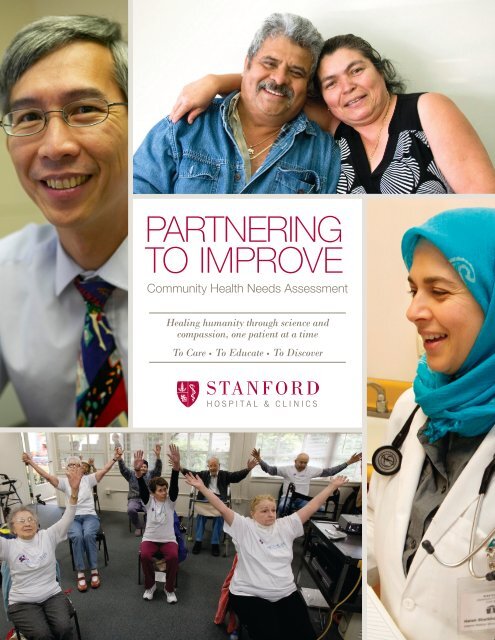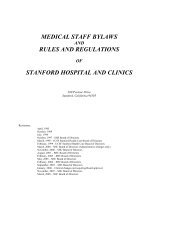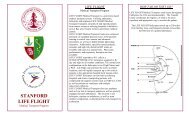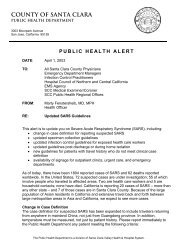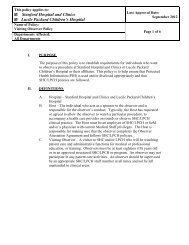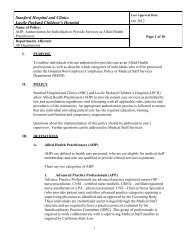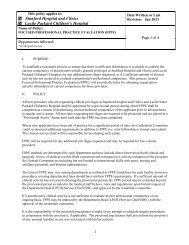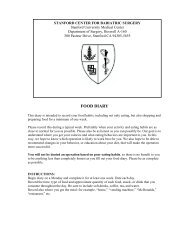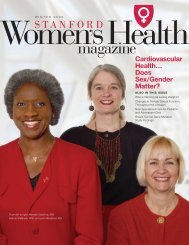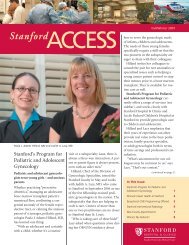FY13 Community Health Needs Assessment - Stanford Hospital ...
FY13 Community Health Needs Assessment - Stanford Hospital ...
FY13 Community Health Needs Assessment - Stanford Hospital ...
You also want an ePaper? Increase the reach of your titles
YUMPU automatically turns print PDFs into web optimized ePapers that Google loves.
PARTNERING<br />
TO IMPROVE<br />
<strong>Community</strong> <strong>Health</strong> <strong>Needs</strong> <strong>Assessment</strong><br />
Healing humanity through science and<br />
compassion, one patient at a time<br />
To Care • To Educate • To Discover
SANTA CLARA COUNTY AND SAN MATEO COUNTY<br />
2013 <strong>Community</strong> <strong>Health</strong> <strong>Needs</strong> <strong>Assessment</strong> (CHNA)
ACKNOWLEDGEMENTS<br />
This report is the result of contributions from many individuals and organizations:<br />
Santa Clara County <strong>Community</strong> Benefit Coalition<br />
El Camino <strong>Hospital</strong>, Barbara Avery, Director of <strong>Community</strong> Benefit<br />
SANTA CLARA COUNTY AND SAN MATEO COUNTY<br />
2013 <strong>Community</strong> <strong>Health</strong> <strong>Needs</strong> <strong>Assessment</strong> (CHNA)<br />
<strong>Hospital</strong> Council of Northern and Central California, Jo Coffaro, Regional Vice President<br />
Kaiser Permanente, Santa Clara and San Jose<br />
Elizabeth Sills, South Bay <strong>Community</strong> Benefit Manager<br />
Joanne Seavey-Hulquist, Senior <strong>Community</strong> Benefit Specialist<br />
Lucile Packard Children’s <strong>Hospital</strong> at <strong>Stanford</strong><br />
Candace Roney, Executive Director of <strong>Community</strong> Partnerships<br />
Colleen Haesloop, Project Manager, <strong>Community</strong> Partnerships<br />
O’Connor <strong>Hospital</strong>, Jennifer Thrift, Manager, Foundations and Corporations<br />
Santa Clara County Public <strong>Health</strong> Department<br />
Anandi Sujeer, <strong>Health</strong> Care Program Manager, Epidemiology and Data Management<br />
Rocio Luna, Division Director, Public <strong>Health</strong> Preparedness and Data Management<br />
<strong>Stanford</strong> <strong>Hospital</strong> & Clinics, Sharon Keating-Beauregard, Coalition Chair, Executive Director of<br />
<strong>Community</strong> Partnerships<br />
Saint Louise Regional <strong>Hospital</strong> , Sister Rachela Silvestri, Director of <strong>Community</strong> <strong>Health</strong><br />
United Way Silicon Valley, Patrick Soricone, Vice President, <strong>Community</strong> Impact<br />
<strong>Health</strong>y <strong>Community</strong> Collaborative of San Mateo County<br />
County of San Mateo Human Service Agency, Jessica Silverberg, Management Analyst, Policy<br />
Planning and Quality Management<br />
<strong>Health</strong> Plan of San Mateo, Daisy Liu, <strong>Health</strong> Educator<br />
<strong>Hospital</strong> Consortium of San Mateo County, Francine Serafin-Dickson, Executive Director<br />
Kaiser Permanente, South San Francisco and Redwood City, Stephan Wahl, <strong>Community</strong> <strong>Health</strong> and<br />
Benefit Manager<br />
Lucile Packard Children’s <strong>Hospital</strong> at <strong>Stanford</strong><br />
Candace Roney, Executive Director, <strong>Community</strong> Partnerships<br />
Colleen Haesloop, Project Manager, <strong>Community</strong> Partnerships<br />
Peninsula <strong>Health</strong> Care District, Cheryl Fama, Chief Executive Officer<br />
San Mateo County <strong>Health</strong> System, Sara T. (ST) Mayer, Director of <strong>Health</strong> Policy and Planning<br />
San Mateo County <strong>Health</strong> System, Scott Morrow, MD, MPH, Collaborative Co-Chair, San Mateo<br />
County <strong>Health</strong> Officer<br />
San Mateo Medical Center, Karen Pugh, Communications
SANTA CLARA COUNTY AND SAN MATEO COUNTY<br />
2013 <strong>Community</strong> <strong>Health</strong> <strong>Needs</strong> <strong>Assessment</strong> (CHNA)<br />
Sequoia <strong>Hospital</strong> , Marie Violet, Collaborative Co-Chair, <strong>Health</strong> and Wellness Services<br />
Seton Medical Center, Jan Kamman, Manager, <strong>Community</strong> Outreach<br />
<strong>Stanford</strong> <strong>Hospital</strong> & Clinics, Sharon Keating-Beauregard, Executive Director of <strong>Community</strong><br />
Partnerships<br />
Sutter <strong>Health</strong> Peninsula Coastal Region, Margie O’Clair, Vice President, Marketing, Communications<br />
and Public Affairs<br />
<strong>Stanford</strong> <strong>Hospital</strong> & Clinics wishes to recognize the following individuals for their extraordinary work on this<br />
project:<br />
Lisa Colvig-Amir Applied Survey Research<br />
Mandeep Baath, Epidemiologist, Santa Clara County Public <strong>Health</strong> Department<br />
Melanie Espino, Applied Survey Research<br />
Donovan Jones, Consultant, San Mateo County <strong>Health</strong> System<br />
Caitlin Kerk, Consultant, Santa Clara County Public <strong>Health</strong> Department<br />
Sara T. (ST) Mayer, Director of <strong>Health</strong> Policy and Planning, San Mateo County <strong>Health</strong> System<br />
Scott Morrow, MD, MPH, San Mateo County <strong>Health</strong> Officer<br />
Anandi Sujeer, <strong>Health</strong> Care Program Manager, Epidemiology and Data Management, Santa Clara<br />
County Public <strong>Health</strong> Department<br />
Jennifer van Stelle, PhD, Applied Survey Research<br />
Claire Wagner, Consultant, Santa Clara County Public <strong>Health</strong> Department
SANTA CLARA COUNTY AND SAN MATEO COUNTY<br />
2013 <strong>Community</strong> <strong>Health</strong> <strong>Needs</strong> <strong>Assessment</strong> (CHNA)<br />
1. Executive Summary .…………………………………………………………………………………………………………..….……1<br />
<strong>Community</strong> <strong>Health</strong> <strong>Needs</strong> <strong>Assessment</strong> (CHNA) Background……………………………………………………......1<br />
Process and Methods……………………………………………………………………………………………………………………1<br />
Prioritization of <strong>Health</strong> <strong>Needs</strong>………………………………………………………………………………………………………2<br />
Next Steps…………………………………………………………………………………………………………………………………….3<br />
2. Introduction/Background…………………………………………………………………………………………………………….4<br />
Purpose of CHNA Report and Affordable Care Act Requirements………………………………………………..4<br />
SB 697 and California’s History with <strong>Community</strong> <strong>Assessment</strong>s…………………………………………………….4<br />
3. About <strong>Stanford</strong> <strong>Hospital</strong> & Clinics………………………………………………………………………………………….……5<br />
<strong>Community</strong> Served………………………………………………………………………………………………………………………5<br />
4. Process and Methods…………………………………………………………………………………………………………………..8<br />
<strong>Community</strong> <strong>Assessment</strong> Teams…………………………………………………………………………………………………….8<br />
Qualifications of Consultants………………………………………………………………………………………………………..9<br />
5. Identification and Prioritization of <strong>Community</strong> <strong>Health</strong> <strong>Needs</strong>……………………………………………………9<br />
Secondary Data Collection……………………………………………………………………………………………………………9<br />
Information Gaps and Limitations………………………………………………………………………………………………10<br />
Primary Data (<strong>Community</strong> Input)……………………………………………………………………………………………….10<br />
Prioritization of <strong>Health</strong> <strong>Needs</strong> San Mateo County………………………………………………………………………15<br />
Prioritization of <strong>Health</strong> <strong>Needs</strong> Santa Clara County……………………………………………………………………..19<br />
Prioritization of <strong>Health</strong> <strong>Needs</strong> San Mateo and Santa Clara Counties………………………………………….20<br />
Summarized Descriptions of Prioritized <strong>Community</strong> <strong>Health</strong> <strong>Needs</strong> San Mateo and Santa Clara<br />
Counties…………………………………………………………………………………………………………………………………….22<br />
6. <strong>Community</strong> Assets…………………………………………………………………………………………………………………….27<br />
7. Conclusion………………………………………………………………………………………………………..………………………..30
SANTA CLARA COUNTY AND SAN MATEO COUNTY<br />
2013 <strong>Community</strong> <strong>Health</strong> <strong>Needs</strong> <strong>Assessment</strong> (CHNA)<br />
8. Lisa of Attachments…………………………………………………………………………………………………………………..31<br />
Attachment 1: Secondary Data Sources Santa Clara County<br />
Attachment 2: Secondary Data Sources San Mateo County<br />
Attachment 3: IRS Checklist<br />
Attachment 4: 2013 <strong>Community</strong> <strong>Health</strong> <strong>Needs</strong> <strong>Assessment</strong>: <strong>Health</strong> & Quality of Life Survey<br />
Attachment 5: Prioritized <strong>Health</strong> <strong>Needs</strong> San Mateo County<br />
Attachment 6: Persons Representing the Broad Interests of the <strong>Community</strong><br />
Attachment 7: <strong>Health</strong> <strong>Needs</strong> Prioritization Scores: Breakdown by Criteria<br />
Attachment 8: CHNA – All Conditions Names During Primary Data Gathering SMC and SCC (66)<br />
Attachment 9: List of Indicators on Which Data Were Gathered (88)<br />
Attachment 10: <strong>Health</strong> <strong>Needs</strong> Profiles<br />
Attachment 11: <strong>Community</strong> Assets San Mateo and Santa Clara counties
1. EXECUTIVE SUMMARY<br />
<strong>Community</strong> <strong>Health</strong> <strong>Needs</strong> <strong>Assessment</strong> (CHNA) Background<br />
SANTA CLARA COUNTY AND SAN MATEO COUNTY<br />
2013 <strong>Community</strong> <strong>Health</strong> <strong>Needs</strong> <strong>Assessment</strong> (CHNA)<br />
The Affordable Care Act (ACA), enacted by Congress on March 23, 2010, stipulates that non-profit hospital<br />
organizations complete a <strong>Community</strong> <strong>Health</strong> <strong>Needs</strong> <strong>Assessment</strong> (CHNA) every three years and make it widely<br />
available to the public. This assessment includes feedback from the community and experts in public health,<br />
clinical care, and others. This CHNA serves as the basis for implementation strategies that are filed with the<br />
Internal Revenue Service (IRS).<br />
The IRS requires the hospital to conduct a CHNA and adopt an implementation strategy for each of its<br />
facilities by the last day of its first taxable year beginning after March 23, 2012. For <strong>Stanford</strong> <strong>Hospital</strong> &<br />
Clinics (SHC), the due date is August 31, 2013.<br />
This report documents how the CHNA was conducted, as well as describes the related findings.<br />
Process and Methods<br />
The Santa Clara County <strong>Community</strong> Benefit Coalition, which includes eight local non-profit hospitals, Santa<br />
Clara County Public <strong>Health</strong> Department, United Way Silicon Valley and other partners, and the <strong>Health</strong>y<br />
<strong>Community</strong> Collaborative of San Mateo County, a coalition of seven local non-profit hospitals, San Mateo<br />
County <strong>Health</strong> System and other partners (see acknowledgements) began the CHNA process in 2012. The<br />
goal was to collectively gather community feedback, understand existing data about health status and<br />
prioritize local health needs in each county.<br />
In Santa Clara County, community input was gathered during the fall of 2012 through interviews with local<br />
health experts, focus groups with community leaders and representatives, and resident focus groups.<br />
Secondary data was obtained from a variety of sources (Attachment 1).<br />
In San Mateo County, resident input was gathered through the 2013 <strong>Community</strong> <strong>Health</strong> <strong>Needs</strong> <strong>Assessment</strong>:<br />
<strong>Health</strong> & Quality of Life Survey. The survey was conducted using a random sample of 1,000 adults in San<br />
Mateo County via landline and cell phones. In addition to the countywide random sampling, additional<br />
surveys were conducted in Coastside zip codes as well as oversampling of African-American residents and<br />
low-income residents, resulting in a total of 1,724 interviews. The secondary data was collected, synthesized<br />
and analyzed from multiple sources by San Mateo County <strong>Health</strong> System (Attachment 2).<br />
In late 2012 through early 2013, health needs were identified by synthesizing primary qualitative research<br />
and secondary data, and then filtering those needs against a set of criteria. <strong>Needs</strong> were then reviewed and<br />
prioritized by countywide groups consisting of members of the county coalitions and community leaders<br />
using another set of criteria. The coalition’s then met again to identify the community resources available to<br />
address the health needs identified through the CHNA process, including hospitals, clinics and communitybased<br />
programs and services.<br />
Page | 1
Prioritization of <strong>Health</strong> <strong>Needs</strong><br />
SANTA CLARA COUNTY AND SAN MATEO COUNTY<br />
2013 <strong>Community</strong> <strong>Health</strong> <strong>Needs</strong> <strong>Assessment</strong> (CHNA)<br />
In February 2013, the SHC <strong>Community</strong> Partnership Program Steering Committee met to review the data<br />
collection and prioritization process that occurred in the community. The purpose of the meeting was to find<br />
those health needs that met certain criteria and would form the basis for SHC’s implementation plan.<br />
The prioritization process is outlined in the pyramid below. The 66 health needs 1 were identified by<br />
community input in both counties and the 88 indicators were selected from multiple secondary data sources.<br />
From the 11 health needs 2 that met all criteria, the committee selected four to address: cancer, access to<br />
care, chronic disease and unintentional injuries (falls). See pages 22-26 for a description of the 11 health<br />
needs.<br />
PROCESS PYRAMID<br />
76 secondary data sources →<br />
88 indicators<br />
66 <strong>Health</strong> <strong>Needs</strong> identified by the<br />
community (SCC and SMC)<br />
Meets SHC Criteria<br />
11 <strong>Health</strong> <strong>Needs</strong><br />
4 <strong>Health</strong><br />
<strong>Needs</strong><br />
1 The basic 66 health needs identified by community input have not been assessed against secondary data at this point.<br />
2 The 11 health needs were selected after evaluation against secondary data and other criteria.<br />
Page | 2
SANTA CLARA COUNTY AND SAN MATEO COUNTY<br />
2013 <strong>Community</strong> <strong>Health</strong> <strong>Needs</strong> <strong>Assessment</strong> (CHNA)<br />
The health needs highlighted in the table below represent those selected by the SHC <strong>Community</strong> Partnership<br />
Program Steering Committee.<br />
Next Steps<br />
11 <strong>Health</strong> <strong>Needs</strong> Identified by CHNA Process<br />
4 <strong>Health</strong> <strong>Needs</strong> Selected by SHC Steering Committee<br />
<strong>Health</strong> <strong>Needs</strong><br />
1. Diabetes<br />
2. Mental health<br />
3. Obesity/overweight<br />
4. Cancer<br />
5. Cardiovascular Disease, Heart Disease, Stroke<br />
6. Access to health care<br />
7. Arthritis<br />
8. Chronic disease<br />
9. Alzheimer’s/dementia<br />
10. Unintentional injuries (falls)<br />
11. Respiratory conditions (asthma, COPD, allergies)<br />
SHC developed its implementation plan for investments in improving the health and well-being of the<br />
community based on:<br />
The health needs identification and prioritization process conducted in each county, which<br />
synthesized primary and secondary data<br />
The health needs prioritization and selection process undertaken by the SHC <strong>Community</strong> Partnership<br />
Program Steering Committee<br />
A review of SHC’s current community health improvement initiatives<br />
Both the CHNA and implementation plan are publically available on SHC’s website as of May 2013.<br />
In addition, the countywide coalitions will continue to meet to explore opportunities for coordinated<br />
interventions around shared health needs.<br />
Page | 3
2. INTRODUCTION/BACKGROUND<br />
Purpose of CHNA Report and Affordable Care Act Requirements<br />
SANTA CLARA COUNTY AND SAN MATEO COUNTY<br />
2013 <strong>Community</strong> <strong>Health</strong> <strong>Needs</strong> <strong>Assessment</strong> (CHNA)<br />
Enacted on March 23, 2010, federal requirements included in the Affordable Care Act (ACA) stipulate that<br />
hospital organizations under 501(c)(3) status must adhere to new regulations, one of which is conducting a<br />
<strong>Community</strong> <strong>Health</strong> <strong>Needs</strong> <strong>Assessment</strong> (CHNA) every three years. The CHNA report must document how the<br />
assessment was done, including the community served, who was involved in the assessment, the process and<br />
methods used to conduct the assessment, and the community’s health needs that were identified and<br />
prioritized as a result of the assessment ( Attachment 3).<br />
As part of the tri-annual CHNA assessment, hospitals must:<br />
Collect and take into account input from public health experts as well as community leaders and<br />
representatives of high-need populations including: minority groups, low-income individuals,<br />
medically underserved populations and those with chronic conditions<br />
Identify and prioritize community health needs<br />
Make the CHNA report widely available to the public<br />
Adopt an Implementation Strategy to address identified health needs<br />
Submit the Implementation Strategy with the annual IRS Form 990<br />
Pay a $50,000 excise tax for failure to meet CHNA requirements for any taxable year<br />
SB 697 and California’s History with <strong>Community</strong> <strong>Assessment</strong>s<br />
Compared to SB 697, the California-specific legislation enacted in 1994 that requires a CHNA, the ACA<br />
regulations for how to conduct and document the needs assessment are more stringent. A comparison is<br />
shown in the table below.<br />
Comparison of ACA and SB 697 CHNA Requirements<br />
Activity or Requirement Required by ACA Required by SB 697<br />
Conduct a CHNA at least once every 3<br />
years<br />
CHNA identifies and prioritizes community<br />
health needs<br />
Input from specific groups/individuals are<br />
gathered<br />
CHNA findings widely available to the<br />
public<br />
Implementation strategy is adopted to<br />
meet needs identified by CHNA<br />
Yes Yes<br />
Yes<br />
(Prioritization of health needs required<br />
before implementation planning)<br />
File an Implementation Plan with IRS Yes<br />
$50,000 excise tax for failure to meet<br />
CHNA requirements for any taxable year<br />
Yes<br />
Yes No<br />
Yes No<br />
Yes Yes<br />
No<br />
(plan filed with the state)<br />
Yes No<br />
Page | 4
3. ABOUT STANFORD HOSPITAL & CLINICS<br />
SANTA CLARA COUNTY AND SAN MATEO COUNTY<br />
2013 <strong>Community</strong> <strong>Health</strong> <strong>Needs</strong> <strong>Assessment</strong> (CHNA)<br />
<strong>Stanford</strong> <strong>Hospital</strong> & Clinics (SHC) is dedicated to providing leading-edge and coordinated care to each and<br />
every patient. It is internationally renowned for expertise in areas such as cancer treatment, neuroscience,<br />
surgery, cardiovascular medicine and organ transplant, as well as for translating medical breakthroughs into<br />
patient care. Throughout its history, <strong>Stanford</strong> has been at the forefront of discovery and innovation, as<br />
researchers and clinicians work together to improve health on a global level. SHC’s vision is healing humanity<br />
through science and compassion, one patient at a time. Its mission is to care, to educate, to discover.<br />
<strong>Hospital</strong><br />
Licensed beds 613 (475 staffed)<br />
Licensed ICU beds 67 (66 operating)<br />
Operating rooms 49<br />
Staff<br />
Medical 2,136<br />
Interns and residents 711<br />
RNs 2,154<br />
LVNs 15<br />
Nursing assistants 141<br />
Nonmedical employees 2,779<br />
Total 7,936<br />
Admissions Per Year<br />
Inpatient visits 25,164<br />
Outpatient visits 643,806<br />
ER visits 53,908<br />
<strong>Community</strong> Served<br />
SHC is a regional referral center for an array of adult specialties, drawing patients from throughout California,<br />
across the country, and internationally. However, a majority of SHC’s patients are residents of San Mateo and<br />
Santa Clara counties. Therefore, for purposes of its community benefit program initiatives, SHC has identified<br />
these two counties as its target community. SHC maintains a strong commitment to the health of its<br />
community members and dedicates considerable resources to support its community partnership program.<br />
SANTA CLARA COUNTY<br />
With 1.8 million residents, Santa Clara County (SCC) is the sixth most populated of California’s 58 counties,<br />
and the most populated county in the Bay Area. More than half of the residents live in San Jose. SCC’s<br />
population is projected to grow from the current level to more than 2.3 million by 2030.<br />
The North County area is extensively urbanized. Thirteen of the county's 15 cities and more than 88 percent<br />
of the county's residents are located in the North County. Gilroy and Morgan Hill, with approximately 5<br />
percent of the county's population, are located in the South County, which remains predominantly rural, with<br />
low-density residential developments scattered though the valley and foothill areas.<br />
Page | 5
SANTA CLARA COUNTY AND SAN MATEO COUNTY<br />
2013 <strong>Community</strong> <strong>Health</strong> <strong>Needs</strong> <strong>Assessment</strong> (CHNA)<br />
According to the 2010 US Census, approximately 36 percent of the population in SCC was born outside of the<br />
United States, outpacing the rate for California by nearly 10 percent. SCC’s racial/ethnic composition is 47<br />
percent White, 32 percent Asian, 27 percent Latino and 3 percent African American. In the most recent<br />
census, approximately 12 percent selected “some other race” and 5 percent selected “more than one race.”<br />
The predominantly reported sub-groups of the Asian population are Chinese (27 percent), Vietnamese (22<br />
percent), Asian Indian (22 percent) and Filipino (15 percent). More than 100 languages and dialects are<br />
spoken in SCC.<br />
Latinos represent the fastest-growing demographic. According to the Silicon Valley Latino Report Card, 82<br />
percent of Latinos in Silicon Valley are from Mexico, with another 8.5 percent from Central America. The<br />
Vietnamese population is another demographic that is growing rapidly in SCC. While there are currently more<br />
Chinese (27 percent) in SCC than Vietnamese (22 percent), the Vietnamese population has grown very quickly<br />
in the last few decades, from 11,717 in 1980 to 134,525 in 2010. The population is the second largest of any<br />
county in the U.S., surpassed only by Orange County, California. San Jose has the largest Vietnamese<br />
population of any U.S. city.<br />
People ages 60 and older make up slightly less of the population in SCC than in California as a whole (16.1<br />
percent vs. 16.8 percent); however, according to the Council on Aging Silicon Valley, “In the coming years,<br />
seniors will comprise a larger and larger share of the local population. In 1990, fewer than 1 in 8 county<br />
residents was age 60 or older. By 2010, that ratio had grown to 1 in 6. By 2030, over 1 in 4 county residents<br />
will be over age 60.” 3<br />
While SCC is one of the most diverse counties in the US, the older adult population is less diverse. Nearly 60<br />
percent of the county's senior residents are White (non-Latino), 24 percent are Asian and 12 percent are<br />
Latino (any race). It is projected that by 2030, the demographic makeup of the county will change<br />
dramatically among the population of adults who are ages 60 and older. By 2030, about 47 percent of older<br />
adults will be White, 29.5 percent will be Asian, and 17.8 percent will be Latino.<br />
On the other hand, young people (ages 17 years and younger) are more diverse than the general population.<br />
These young people make up about 25 percent of SCC’s population. While Latinos are 27 percent of SCC’s<br />
overall population, they represent more than 35 percent of the youth population. In 2011, more than 25<br />
percent of children were English-language learners.<br />
The percentage of children living below the Federal Poverty Level (FPL) has increased by 2.6 percent since<br />
2000. In SCC, more Hispanic/Latino and African-American children are living in poverty compared to children<br />
of other racial/ethnic groups and the county overall. In 2012, the national FPL for a family of four was<br />
$23,050. According to this measure, nearly 1 in 10 children (11 percent) and 1 in 12 adults (9 percent) are<br />
living in poverty.<br />
Because the FPL does not take into consideration local conditions such as cost of living, other measures of<br />
economic security are used to provide a more realistic measure of poverty in SCC. The Family Economic Self-<br />
Sufficiency Standard (FESSS) estimates that an annual income of $59,140 is necessary for a family of three<br />
3 Council on Aging Silicon Valley Area Plan 2012-2016; 2012<br />
Page | 6
SANTA CLARA COUNTY AND SAN MATEO COUNTY<br />
2013 <strong>Community</strong> <strong>Health</strong> <strong>Needs</strong> <strong>Assessment</strong> (CHNA)<br />
(one adult and two children ages 3-5) to meet their most basic expenses; this is equivalent to more than four<br />
full-time minimum-wage jobs. 4<br />
Nearly half of SCC older adults are economically insecure, with incomes too low to meet their basic needs<br />
without additional assistance. According to the Elder Economic Security Index 5 (Elder Index), a measure that<br />
provides a county-specific indicator of senior poverty, 67 percent of Latino seniors and 76 percent of Asian<br />
seniors are living in impoverished conditions, compared with just 32 percent of White (non-Latino) seniors.<br />
Additionally, female seniors and seniors ages 75 and older (any gender) are more likely to experience poverty<br />
compared to male seniors and those between the ages of 65 and 74.<br />
SAN MATEO COUNTY<br />
San Mateo County (SMC), located on the San Francisco Peninsula is made up of 20 cities and towns, bordered<br />
by the City of San Francisco on the north, the San Francisco Bay on the east, Santa Clara County on the south,<br />
and the Pacific Ocean on the west. SMC is a mix of urban and suburban industrial, small business, and<br />
residential use. The coastal area is a mix of suburban and rural with significant agricultural, fishing, small<br />
business and tourism land use. According to the 2010 U.S. Census, the county’s population is 719,467. SMC’s<br />
population is expected to increase by 14 percent from 2010 to 2050.<br />
SMC is among the richest counties in terms of ethnic diversity. From 2006 to 2010, 34 percent of the county<br />
population was foreign born and nearly half (45 percent) of those ages 4 and older spoke a language other<br />
than English at home. Over the next four decades, the White population is expected to decrease by nearly 50<br />
percent, while Hispanic and Asian/Pacific Islander populations are expected to increase dramatically. By the<br />
year 2050, the ethnic makeup of the county is projected to be 38 percent Hispanic, 32 percent Asian/Pacific<br />
Islander, 22 percent White, 5 percent African-American, and 4 percent other/multi-race.<br />
While other age groups will decrease in terms of the percentage of the county population from 2010 to 2050,<br />
those ages 60 and older will increase from 18.9 percent to 30.9 percent. Asian/Pacific Islander and Hispanic<br />
seniors will comprise the largest proportion of seniors in SMC in 2050. At the other end of the age spectrum,<br />
the ethnic makeup of children ages 14 and younger is projected to be Hispanic, Asian/Pacific Islander, White,<br />
African-American, and multi-race in 2050.<br />
In 2010, median income for SMC residents ages 25 and older was $47,060 and the average weekly wage was<br />
$1,450, down 13 percent from 2000. According to the U.S. Census Bureau, from 2006 to 2010, the<br />
percentage of SMC individuals below the FPL was 7 percent, with 9.1 percent of children ages 18 and younger<br />
below the FPL.<br />
According to the FESSS, a single parent with two children living in SMC must earn approximately $78,000<br />
annually to meet the family’s basic needs, the equivalent of nearly five full-time minimum-wage jobs.<br />
According to the Elder Index, 36 percent of seniors struggle to cover basic expenses and if their annual<br />
income exceeds the FPL ($10,830), they may be ineligible for public-assistance programs.<br />
4 Developed by the Insight Center for <strong>Community</strong> Economic Development, the FESSS is a comprehensive measure of how much it costs for<br />
working families to live, adjusted for regional differences in prices and the ages of the children in the household; 2011<br />
5<br />
The Elder Index is a county level indicator to measure the minimum income necessary to cover all of an older adult’s basic expenses, including<br />
housing, food, medical care and transportation.<br />
Page | 7
4. PROCESS AND METHODS<br />
SANTA CLARA COUNTY AND SAN MATEO COUNTY<br />
2013 <strong>Community</strong> <strong>Health</strong> <strong>Needs</strong> <strong>Assessment</strong> (CHNA)<br />
The coalitions in both counties have been working together for several years on prior assessments and other<br />
projects. The data collection process for this <strong>Community</strong> <strong>Health</strong> <strong>Needs</strong> <strong>Assessment</strong> (CHNA) took place over a<br />
seven-month period as illustrated below.<br />
Secondary<br />
Data<br />
July-Dec<br />
2012<br />
Primary Data<br />
Collection<br />
Oct 2012-Feb<br />
2013<br />
<strong>Community</strong> <strong>Assessment</strong> Teams<br />
CHNA Process<br />
The Santa Clara County <strong>Community</strong> Benefit Coalition— a collaboration of eight local non-profit hospitals,<br />
Santa Clara County Public <strong>Health</strong> Department, <strong>Hospital</strong> Council of Northern and Central California, and<br />
United Way Silicon Valley— worked together to complete the CHNA. Non-profit hospital members included<br />
El Camino <strong>Hospital</strong>, Kaiser Permanente Santa Clara, Kaiser Permanente San Jose, Lucile Packard Children’s<br />
<strong>Hospital</strong> at <strong>Stanford</strong>, O’Connor <strong>Hospital</strong>, Saint Louise Regional <strong>Hospital</strong>, and <strong>Stanford</strong> <strong>Hospital</strong> & Clinics. This<br />
team contracted with Applied Survey Research (ASR) and Research Development Associates (RDA) to assist<br />
with the CHNA in 2012.<br />
The <strong>Health</strong>y <strong>Community</strong> Collaborative of San Mateo County is a coalition of seven local non-profit hospitals<br />
including Kaiser Permanente South San Francisco, Kaiser Permanente Redwood City, Lucile Packard Children’s<br />
<strong>Hospital</strong> at <strong>Stanford</strong>, Sequoia <strong>Hospital</strong>, Seton Medical Center, <strong>Stanford</strong> <strong>Hospital</strong> & Clinics, and Sutter <strong>Health</strong><br />
Peninsula Coastal Region as well as San Mateo County <strong>Health</strong> System, <strong>Health</strong> Plan San Mateo, <strong>Hospital</strong><br />
Consortium of San Mateo County, San Mateo County Human Services Agency, Peninsula <strong>Health</strong> Care District,<br />
San Mateo Medical Center, and San Mateo County <strong>Health</strong> System. The collaborative conducted the SMC<br />
CHNA with assistance from ASR and Professional Research Consultants, Inc. (PRC) in the prioritization of<br />
health needs and the collection of primary data.<br />
Qualifications of Consultants<br />
<strong>Health</strong> <strong>Needs</strong><br />
Identified by<br />
<strong>Community</strong><br />
NOV 2012 - Feb<br />
2013<br />
Prioritization<br />
Nov 2012-<br />
Feb 2013<br />
Assets<br />
Review<br />
Dec 2012-<br />
Feb 2013<br />
Report<br />
Writing<br />
Feb-Apr 2013<br />
ASR, a non-profit social research firm, was commissioned to assist with the assessment. ASR conducted<br />
primary research, synthesized primary and secondary data, facilitated the process of identification and<br />
prioritization of community health needs and assets, and documented the process and findings in a report.<br />
Page | 8
SANTA CLARA COUNTY AND SAN MATEO COUNTY<br />
2013 <strong>Community</strong> <strong>Health</strong> <strong>Needs</strong> <strong>Assessment</strong> (CHNA)<br />
ASR is well known for its expertise in community assessments. IN 2007, the firm won a national award from<br />
the <strong>Community</strong> Indicator Consortium and the Brookings Institution for having the best community<br />
assessment project in the country. They accomplish successful assessments by using mixed research methods<br />
to help understand the needs, and by putting the research into action through designing and facilitating<br />
strategic planning efforts with stakeholders.<br />
The Santa Clara County <strong>Community</strong> Benefit Coalition also contracted with RDA to do secondary data<br />
collection. RDA is a 28-year-old Bay Area consulting firm supporting government agencies and communitybased<br />
organizations with assessment, planning, evaluation, data system development and analysis, and grant<br />
writing. RDA employs a full-time staff of 24 professionals with credentials in public health, clinical services,<br />
social welfare, organizational development and planning.<br />
In San Mateo County, the 2013 <strong>Community</strong> <strong>Health</strong> <strong>Needs</strong> <strong>Assessment</strong>: <strong>Health</strong> & Quality of Life Survey was<br />
conducted by PRC, a nationally recognized healthcare consulting firm. PRC has extensive experience<br />
conducting community health needs assessments in hundreds of communities across the United States since<br />
1994. The secondary data was collected from multiple sources (Attachment 2) by San Mateo County <strong>Health</strong><br />
System.<br />
5. IDENTIFICATION AND PRIORITIZATION OF COMMUNITY HEALTH NEEDS<br />
Secondary Data Collection<br />
In San Mateo County, the secondary data was collected from multiple sources. It was then synthesized and<br />
analyzed by San Mateo County <strong>Health</strong> System under the direction of the San Mateo County <strong>Health</strong> Officer,<br />
Dr. Scott Morrow, MD, MPH, and the Director of <strong>Health</strong> Policy and Planning, San Mateo County <strong>Health</strong><br />
System, Sara T. (ST) Mayer.<br />
In Santa Clara County, Research Development Associates (RDA) created a compendium of secondary data<br />
(Attachment 1). The Santa Clara County <strong>Community</strong> Benefit Coalition made available to RDA a selection of<br />
the most recent and comprehensive public health-related reports and documents as well as demographic<br />
data. One report in particular, the Santa Clara County <strong>Health</strong> Profile, 2012, served as the “foundational<br />
report” due to its comprehensive compilation of recent countywide public health data.<br />
As a further framework for the assessment, the coalition requested that RDA use the following filters:<br />
What health areas offer the most current and consistent data?<br />
What are the most salient/meaningful indicators?<br />
How do these indicators perform against accepted benchmarks?<br />
Are there disparate outcomes and conditions for people in the community?<br />
Are there opportunities for the county’s hospitals to positively impact outcomes to improve the<br />
health and quality of life for county residents?<br />
RDA compiled the research and provided comparisons with existing benchmarks (<strong>Health</strong>y People 2020,<br />
statewide and national averages) in its compendium. The compendium was intended to provide a rich picture<br />
of the health of the county. Secondarily, it was created with an understanding of how hospitals could make<br />
Page | 9
SANTA CLARA COUNTY AND SAN MATEO COUNTY<br />
2013 <strong>Community</strong> <strong>Health</strong> <strong>Needs</strong> <strong>Assessment</strong> (CHNA)<br />
use of this data to plan their community benefit priorities, conduct their outreach and education efforts, and<br />
develop strategies for engaging partners to address identified needs.<br />
Information Gaps & Limitations<br />
The coalitions were limited in their ability to assess some of the identified community health needs due to a<br />
lack of secondary data. Such limitations included data on oral/dental health, substance abuse (particularly<br />
use of illegal drugs and misuse of prescription medication), dementia, and mental health. More specific<br />
limitations included lack of county data on bullying, effects of gun violence, ethnic subgroups affected by<br />
hepatitis B, suicide among LGBTQ 6 youth, diabetes among children, Asian population by subgroup, chronic<br />
disease prevalence, more granular geographical data (e.g., by neighborhood or street address), and lack of<br />
extended data on breastfeeding.<br />
There were also limitations on how the coalitions were able to understand the needs of special populations<br />
including LGBTQ individuals and undocumented immigrants. Due to the small numbers of these community<br />
members, many data are statistically unstable and do not lend themselves to predictability.<br />
Primary Data (<strong>Community</strong> Input)<br />
Overview<br />
In Santa Clara County, Applied Survey Research (ASR) conducted the primary research using three strategies<br />
for collecting community input: interviews with health experts, focus groups with community leaders and<br />
stakeholders, and resident focus groups.<br />
In San Mateo County, primary research was gathered by Professional Research Consultants, Inc. (PRC)<br />
through a telephone survey of adults, the 2013 <strong>Community</strong> <strong>Health</strong> <strong>Needs</strong> <strong>Assessment</strong>: <strong>Health</strong> & Quality of<br />
Life Survey (Attachment 4). The phone surveys reached populations represented by those who are medically<br />
underserved and have chronic conditions as well as low-income and minority populations.<br />
Resident Input San Mateo County<br />
The phone survey was conducted among a random sample of 1,000 adults in San Mateo County; 80 percent<br />
were landline telephones and 20 percent were cell phones. In addition to the countywide random sampling,<br />
additional surveys were conducted, resulting in a total of 1,724 interviews:<br />
300 additional interviews in Coastside ZIP Codes in order to augment samples and enhance reliability<br />
within that area and to make it comparable to data collected in previous surveys<br />
Oversample of African-American residents to allow for analysis of this important subsample<br />
Oversample of low-income residents (those living below 400 percent of the Federal Poverty Level<br />
(FPL) to allow for better analysis of this population segment<br />
The interviews were conducted randomly. The final responses were then “weighted” by several key<br />
geographic and demographic characteristics to more closely match the countywide and sub-county<br />
populations, and to achieve greater statistical representativeness.<br />
6 LGBTQ: Lesbian, Gay, Bisexual, Transgender, Questioning<br />
Page | 10
SANTA CLARA COUNTY AND SAN MATEO COUNTY<br />
2013 <strong>Community</strong> <strong>Health</strong> <strong>Needs</strong> <strong>Assessment</strong> (CHNA)<br />
The numbers of actual interviews conducted by key demographic segments are outlined in the following<br />
table, as well as the distribution of weighted respondents. The table also describes the confidence intervals<br />
and population estimates associated with key demographic and geographic segments. Note that some<br />
categories may not add up to the total number of interviews due to non-response/non-classification, or in<br />
the case of race/ethnicity and region, because respondents may fall within more than one classification. Error<br />
rate estimates are made at the 95 percent confidence level (p= .05). Population equivalents are based on<br />
estimates of the adult population (ages 18 and older). Estimates for education, poverty, and race/ethnicity<br />
are based on proportions achieved through random sampling.<br />
Page | 11
SANTA CLARA COUNTY AND SAN MATEO COUNTY<br />
2013 <strong>Community</strong> <strong>Health</strong> <strong>Needs</strong> <strong>Assessment</strong> (CHNA)<br />
Numbers of Actual Interviews, Weighted Responses, Confidence Intervals & Populations Estimates<br />
Gender<br />
Interviews<br />
Conducted<br />
Weighted<br />
Responses<br />
Maximum<br />
Error Rate<br />
Population Equivalent<br />
(1%= # Adults)<br />
Male 747 833 ±3.6% 2,760<br />
Female 977 891 ±3.1% 2,953<br />
Age<br />
18 to 39 Years 298 631 ±5.7% 2,142<br />
40 to 64 Years 832 773 ±3.4% 2,624<br />
65 Years or Older 547 279 ±4.2% 947<br />
Education<br />
High School or Less 340 301 ±5.3% 1,002<br />
Postsecondary Education 1,374 1,415 ±2.6% 4,711<br />
Poverty Status<br />
400% Poverty Level 670 752 ±3.8% 3,247<br />
Race/Ethnicity<br />
White 1,145 850 ±2.9% 2,835<br />
Hispanic 345 377 ±5.3% 1,257<br />
Asian/Pacific Islander 149 431 ±8.1% 1,437<br />
Black 125 55 ±8.8% 183<br />
Region<br />
North County 476 663 ±4.5% 2,194<br />
Mid-County 390 563 ±5.0% 1,866<br />
South County 512 433 ±4.3% 1,435<br />
Coastside 346 66 ±5.2% 219<br />
TOTAL SAMPLE 1,724 1,724 ±2.4% 5,713<br />
Page | 12
<strong>Community</strong> Leader Input San Mateo County<br />
SANTA CLARA COUNTY AND SAN MATEO COUNTY<br />
2013 <strong>Community</strong> <strong>Health</strong> <strong>Needs</strong> <strong>Assessment</strong> (CHNA)<br />
In San Mateo County, ASR conducted a focus group of 20 local community leaders and stakeholders on<br />
January 30, 2013. The purpose of this convening was to elicit feedback and assistance in prioritizing health<br />
needs identified through the CHNA process.<br />
<strong>Community</strong> leaders who attended the focus group are listed in the following table.<br />
Name Title Organization Representing<br />
Bowdish, Rev. Dr. Lynn Pastor, <strong>Community</strong> Activist Holy Child and St. Martin Episcopal Church<br />
Brown, Pat Executive Director Redwood City 2020<br />
Clark, Erin Intern Peninsula <strong>Health</strong> Care District<br />
Dambrowski, Kristen Associate Executive Director Peninsula Family YMCA<br />
Fama, Cheryl CEO Peninsula <strong>Health</strong> Care District<br />
Gillette, Kimberly Director Daly City Youth <strong>Health</strong> Center<br />
Groom, Carole Supervisor San Mateo County Board of Supervisors<br />
Herzberg, Sam Senior Planner San Mateo County Parks and Recreation<br />
Kandals, Lori Executive Director Caminar<br />
Liedtke, Barbara South City Home Share Coordinator Human Investment Project Housing<br />
Liu, Daisy <strong>Health</strong> Educator <strong>Health</strong> Plan of San Mateo<br />
Michelson, Lee CEO Sequoia <strong>Health</strong>Care District<br />
Mitchell, Sara Larios CEO Star-Vista<br />
Myers, Ron Chief, North County Fire San Mateo County Fire Chief<br />
Peterson, Sharon Director of Operations Samaritan House<br />
Roberts, Emily Child <strong>Health</strong> and Development Specialist FIRST 5 San Mateo County<br />
Tauaalo, Foncet Intern San Mateo County Human Services Agency<br />
Times, Rita Advisory Board Member African American <strong>Community</strong> <strong>Health</strong> Advisory<br />
Torres, Deborah Director San Mateo County Human Services Agency<br />
Wolf, Art Sr. Development Officer Peninsula Jewish <strong>Community</strong> Center<br />
Page | 13
Results of the focus group yielded the health needs listed in the following table.<br />
SANTA CLARA COUNTY AND SAN MATEO COUNTY<br />
2013 <strong>Community</strong> <strong>Health</strong> <strong>Needs</strong> <strong>Assessment</strong> (CHNA)<br />
<strong>Health</strong> Need Indicators of Need<br />
Obesity<br />
Percentage of people who are obese is rising<br />
Cardiovascular disease, heart attack, and stroke<br />
(cerebrovascular disease)<br />
Percentage of people who exhibit more than one risk factor<br />
for cardiovascular disease is not decreasing<br />
Substance use (ATOD) Youth drug arrests and binge drinking are rising<br />
Poor oral health High self-reported lack of access to dental care in youth, and<br />
percentage of people who lack dental insurance is rising<br />
Violence Perception of violence and lack of neighborhood safety is a<br />
concern, particularly gang and domestic violence<br />
Infectious disease Tuberculosis is increasing<br />
Diabetes Percentage of people with diabetes is continually rising<br />
Poor mental health Poor mental health indicators are staying the same or rising<br />
(e.g., depression and suicide rates)<br />
Cancer Incidence rates of breast, cervical, colorectal and prostate<br />
cancer are failing <strong>Health</strong>y People 2020 benchmarks<br />
Births C-sections are rising and some ethnicities receive<br />
inadequate prenatal care<br />
Asthma and respiratory conditions Asthma prevalence is worsening<br />
STDs, including HIV/AIDS HIV screening is low among some populations and STDs are<br />
on the rise<br />
Participants identified additional health needs that they felt were important:<br />
Accidents and injuries (e.g., falls, motor vehicle)<br />
Chronic disease (both age-related and due to disabilities)<br />
<strong>Health</strong> of older adults<br />
Cognitive issues (Alzheimer’s disease, autism)<br />
Access to care issues<br />
<strong>Hospital</strong> readmissions<br />
Sexual abuse/trafficking of teens<br />
Suicides<br />
Child maltreatment among African-Americans and immigrants<br />
Prioritization of <strong>Health</strong> <strong>Needs</strong> San Mateo County<br />
Each health need was ranked across four dimensions on a scale of one to three. The dimensions were:<br />
Clear disparities or inequities exist<br />
Presents a prevention/early intervention opportunity<br />
Impacts quality of life<br />
Is a priority for the community<br />
Page | 14
SANTA CLARA COUNTY AND SAN MATEO COUNTY<br />
2013 <strong>Community</strong> <strong>Health</strong> <strong>Needs</strong> <strong>Assessment</strong> (CHNA)<br />
Each participant was given an electronic voting device. Their votes were averaged for each of the dimensions,<br />
and an overall average score was generated for each health need (Attachment 5).<br />
Resident Input Santa Clara County<br />
ASR conducted eight resident focus groups in Santa Clara County in October and November 2012. The<br />
discussion centered around four questions that were modified appropriately for the audience.<br />
How healthy is our community?<br />
What are the health needs that you see in the community?<br />
What are the most pressing health needs on this list?<br />
What are the drivers of these prioritized conditions?<br />
In order to provide a voice to the community it serves in Santa Clara County, the assessment team targeted<br />
participants who were medically underserved, in poverty, socially or linguistically isolated, or who had<br />
chronic conditions. The team conducted two groups with a special population focus: seniors and parents of<br />
young children.<br />
These groups were located in various geographic areas around the county. Residents were recruited by nonprofit<br />
hosts such as <strong>Community</strong> <strong>Health</strong> Partnership, which serves the uninsured.<br />
Resident Participant Demographics<br />
Fifty community members participated in the focus group discussions in Santa Clara County. All participants<br />
completed an anonymous demographic survey, the results of which are reflected below.<br />
90 percent of participants were ethnic minorities and English was a second language for most<br />
44 percent of residents were younger than age 40, including seven youth younger than age 20<br />
36 percent were middle-aged (ages 40 to 50)<br />
16 percent were older adults (ages 60 and older)<br />
Almost a third of the participants were uninsured, while 46 percent had benefits through Medi-Cal,<br />
Medicare, or another public insurance program<br />
Almost two-thirds of the residents lived in medically underserved areas of the county: South county<br />
cities of Morgan Hill, Gilroy, and San Martin; East San Jose; and the Mayview area of Sunnyvale<br />
Most households were comprised of multiple adults age 26 and older(65 percent)and a child or<br />
youth ages 24 and younger<br />
About half (48 percent) of the participants had children ages 17 and younger in their households.<br />
Among the participants who lived in a household with children, the average number of children was<br />
two<br />
A third of respondents reported having at least one young adult ages 18 to 24 in their households<br />
Of those who responded to the question about annual household income, all but two respondents<br />
reported having an annual household income of less than $45,000 per year.<br />
Page | 15
SANTA CLARA COUNTY AND SAN MATEO COUNTY<br />
2013 <strong>Community</strong> <strong>Health</strong> <strong>Needs</strong> <strong>Assessment</strong> (CHNA)<br />
The vast majority of participants (79%) earned less than $25,000 per year, which is near the FPL for a<br />
family of four, and below the California Self-Sufficiency Standard for two adults with no children<br />
($45,609). This demonstrates a high level of need among participants in an area where the cost of<br />
living is extremely high compared to other areas of California.<br />
Income of <strong>Community</strong> Members Participating in Focus Groups<br />
Annual household Income Participants<br />
Under $25,000 37<br />
$25,000-$44,000 8<br />
$45,000-$64,000 1<br />
$65,000-$84,000 1<br />
Missing 3<br />
Grand Total 50<br />
<strong>Community</strong> Leader Input Santa Clara County<br />
In all, ASR consulted with more than 50 community representatives of the organizations and sectors listed<br />
below. These representatives either work in the health field, or improve health conditions by serving those<br />
from the target populations.<br />
Santa Clara County Public <strong>Health</strong> Department<br />
Santa Clara County <strong>Health</strong> and <strong>Hospital</strong> System<br />
<strong>Hospital</strong>s/hospital systems<br />
<strong>Health</strong> Insurance providers<br />
Mental/behavioral health or violence prevention providers<br />
School system representatives<br />
<strong>Community</strong> center representatives<br />
Non-profit agencies providing basic needs<br />
Other non-profit agencies serving children, seniors, and families<br />
See Attachment 6 for the names, titles, and expertise of key stakeholders along with the date and mode of<br />
consultation (focus group or key informant interview).<br />
Key Informant Interviews<br />
In Santa Clara County, ASR conducted primary research through interviews with nine South Bay experts from<br />
various organizations in the health sector including public health officers, community clinic managers, and<br />
clinicians.<br />
<strong>Health</strong> experts were interviewed by telephone and were asked to discuss one of the areas of focus for the<br />
CHNA: health delivery, health access, socio-economic factors, health behaviors, environmental conditions,<br />
quality of life (morbidity), and mortality.<br />
Page | 16
1. René Santiago<br />
Key Informant Interviews<br />
Name Position Agency<br />
Deputy County<br />
Executive<br />
SANTA CLARA COUNTY AND SAN MATEO COUNTY<br />
2013 <strong>Community</strong> <strong>Health</strong> <strong>Needs</strong> <strong>Assessment</strong> (CHNA)<br />
Santa Clara Valley <strong>Health</strong> and<br />
<strong>Hospital</strong> System<br />
2. Shamima Hasan CEO Mayview <strong>Community</strong> <strong>Health</strong><br />
3. Dan Peddycord Director Santa Clara County Public <strong>Health</strong><br />
Department<br />
4. Dr. Marty Fenstersheib <strong>Health</strong> Officer Santa Clara County<br />
5. Reymundo Espinoza CEO Gardner <strong>Health</strong> Center<br />
6. Michelle Lew Executive Director. Asian Americans for <strong>Community</strong><br />
Involvement<br />
7. Dolores Alvarado Executive Director <strong>Community</strong> <strong>Health</strong> Partnership<br />
8. Dr. Kent Imai Medical Director <strong>Community</strong> <strong>Health</strong> Partnership<br />
9. Dr. Thad Padua Medical Director Santa Clara Family <strong>Health</strong> Plan<br />
Stakeholder Focus Groups<br />
Focus groups with stakeholders were conducted in October and November 2012. The groups represented<br />
various community-based organizations including those that serve populations with chronic conditions,<br />
seniors, children and youth, the medically underserved, those requiring basic needs, etc. See Attachment 6<br />
for a full list of community leaders/stakeholders and their credentials.<br />
The discussion centered around four questions, which were modified appropriately for the audience.<br />
How healthy is our community?<br />
What are the health needs that you see in the community?<br />
What are the most pressing health needs on this list?<br />
What are the drivers of these prioritized conditions?<br />
Each group and interview was recorded and summarized. When all groups had been conducted, the team<br />
used qualitative research software tools to analyze the information and tabulated all health conditions that<br />
were mentioned, along with health drivers discussed. ASR then made a list of all of the conditions that had<br />
been mentioned by a focus group or key informant.<br />
Collectively, the community identified a diverse set of health conditions (see the table below). They spoke<br />
about prevention, access to care, clinical practices that work and don’t work, and their overall perception of<br />
the community’s health.<br />
Page | 17
SANTA CLARA COUNTY AND SAN MATEO COUNTY<br />
2013 <strong>Community</strong> <strong>Health</strong> <strong>Needs</strong> <strong>Assessment</strong> (CHNA)<br />
All <strong>Health</strong> Conditions Named During Primary Data Gathering- Santa Clara County<br />
Substance abuse/behavioral health (including prescription medication abuse)<br />
Diabetes, poor nutrition<br />
Cardiovascular disease (heart disease, stroke, congestive heart failure, hypertension)<br />
Poor mental health, trauma, suicide, depression, anxiety, stress, cutting<br />
Obesity/overweight<br />
Violence (including abuse and bullying)<br />
Respiratory conditions (asthma, allergies, bronchitis, COPD)<br />
Cancer<br />
Poor oral/dental health<br />
Teen pregnancy<br />
Access to care<br />
Acute/episodic issues (e.g., ulcers, skin diseases)<br />
ADD/ADHD, learning disabilities<br />
Anemia<br />
Arthritis<br />
Autism/Asperger's<br />
Chronic diseases<br />
Deformities<br />
Dementia/Alzheimer's<br />
Drowning<br />
Emphysema<br />
Falls/injury<br />
Fatigue<br />
Hepatitis B and C<br />
Page | 18
High cholesterol<br />
Infant mortality<br />
Jaundice<br />
Kidney stones<br />
Low birth weight<br />
Parkinson's<br />
Pregnancy-related conditions<br />
Premature births<br />
Sciatica<br />
Sleep apnea/sleep disorders<br />
Social/emotional development<br />
STDs/unhealthy sexual behavior<br />
Stroke<br />
Thyroid disease<br />
Trauma<br />
Viruses<br />
Vision problems (e.g., glaucoma and cataracts)<br />
Prioritization of <strong>Health</strong> <strong>Needs</strong> Santa Clara County<br />
SANTA CLARA COUNTY AND SAN MATEO COUNTY<br />
2013 <strong>Community</strong> <strong>Health</strong> <strong>Needs</strong> <strong>Assessment</strong> (CHNA)<br />
Before beginning the prioritization process, the coalition chose a set of criteria to use. The criteria were:<br />
Existence of clear disparities/inequities among subpopulations in the community<br />
An opportunity to intervene at the prevention or early intervention level<br />
A successful solution has the potential to solve multiple problems.<br />
The community prioritizes the issue over other issues<br />
The results of this process are presented in rank order in Attachment 7.<br />
Page | 19
Prioritization of <strong>Health</strong> <strong>Needs</strong> San Mateo and Santa Clara Counties<br />
SANTA CLARA COUNTY AND SAN MATEO COUNTY<br />
2013 <strong>Community</strong> <strong>Health</strong> <strong>Needs</strong> <strong>Assessment</strong> (CHNA)<br />
In February 2013, the <strong>Stanford</strong> <strong>Hospital</strong> & Clinics (SHC) <strong>Community</strong> Partnership Program Steering Committee<br />
met to review the data collection and prioritization process that occurred in the community. The purpose of<br />
the meeting was to find those health needs that met the criteria listed below and would form the basis for<br />
SHC’s implementation plan.<br />
The committee consists of Chairperson Nancy Lee, Chief Nursing Officer and Vice President of Patient Care<br />
Services; Bryan Bohman, MD, Associate Chief Medical Officer; Jason Wong, MD, Medical Director of<br />
Samaritan House Redwood City Free Clinic; Andy Coe, Chief Government and <strong>Community</strong> Relations Officer;<br />
Eric Williams, Executive Director Solid Organ Transplant; Nora Cain, Director of the <strong>Stanford</strong> <strong>Health</strong> Library;<br />
and Sharon Keating-Beauregard, Executive Director of <strong>Community</strong> Partnerships.<br />
The prioritization process is outlined in the pyramid below. The 66 health needs were identified by<br />
community input in both counties (Attachment 8) and the 88 indicators (Attachment 9) were selected from<br />
multiple secondary data sources.<br />
Process Pyramid<br />
76 secondary data sources →<br />
88 indicators<br />
66 <strong>Health</strong> <strong>Needs</strong> identified by the<br />
community (SCC and SMC)<br />
Meets SHC Criteria<br />
11 <strong>Health</strong> <strong>Needs</strong><br />
4 <strong>Health</strong><br />
<strong>Needs</strong><br />
Page | 20
SANTA CLARA COUNTY AND SAN MATEO COUNTY<br />
2013 <strong>Community</strong> <strong>Health</strong> <strong>Needs</strong> <strong>Assessment</strong> (CHNA)<br />
The 88 indicators were selected to present the most robust picture of the health of the community. They are<br />
meant to answer the following questions:<br />
Who lives in the community?<br />
Where are the areas of greatest need within the target area?<br />
What are the major health issues faced by the community?<br />
What is causing the health issues identified?<br />
The SHC <strong>Community</strong> Partnership Program Steering Committee identified 11 health needs (shown in the table<br />
below) by applying the following criteria to the list of 66 health needs:<br />
Supported by primary data (community input) and secondary data<br />
Misses a benchmark (HP 2020 or California state average)<br />
Cuts across both San Mateo and Santa Clara counties<br />
Affects a relatively large number of individuals<br />
If left unaddressed, is likely to become more serious<br />
Has a serious impact at the individual, family, or community level<br />
Is one in which SHC has the required expertise and human and financial resources to make an impact<br />
The committee also reviewed SHC’s current community health improvement initiatives and, along with the<br />
health needs from the CHNA process, selected four of the health needs to address: cancer, access to care,<br />
chronic disease and unintentional injuries(falls). Of the seven other health needs, four are indirectly<br />
addressed through the current <strong>Community</strong> Partnership Program health initiatives: diabetes, cardiovascular<br />
disease and stroke, arthritis, and respiratory conditions such as asthma and COPD).<br />
11 <strong>Health</strong> <strong>Needs</strong> Identified by CHNA Process<br />
4 <strong>Health</strong> <strong>Needs</strong> Selected by SHC Steering Committee<br />
<strong>Health</strong> <strong>Needs</strong><br />
1. Diabetes<br />
2. Mental health<br />
3. Obesity/overweight<br />
4. Cancer<br />
5. Cardiovascular disease, heart disease, stroke<br />
6. Access to health care<br />
7. Arthritis<br />
8. Chronic disease<br />
9. Alzheimer’s/dementia<br />
10. Unintentional injuries (falls)<br />
11. Respiratory conditions (asthma, COPD, allergies)<br />
Page | 21
SANTA CLARA COUNTY AND SAN MATEO COUNTY<br />
2013 <strong>Community</strong> <strong>Health</strong> <strong>Needs</strong> <strong>Assessment</strong> (CHNA)<br />
SHC developed its implementation strategy for investments in improving the health and well-being of the<br />
community based on:<br />
The health needs identification and prioritization process conducted in each county, which<br />
synthesized primary and secondary data<br />
The health needs prioritization and selection process undertaken by the SHC <strong>Community</strong> Partnership<br />
Program Steering Committee<br />
A review of SHC’s current community health improvement initiatives<br />
Summarized Descriptions: Prioritized Santa Clara County and San Mateo County<br />
<strong>Health</strong> <strong>Needs</strong><br />
For more details, see Attachment 10, <strong>Health</strong> <strong>Needs</strong> Profiles.<br />
Access to health care is a health need in Santa Clara County and San Mateo County.<br />
In Santa Clara County (SCC), the percentage of uninsured residents ages 18-64 increased from 9 to 21 percent<br />
from 2000 to 2009 and is now higher than both state and national figures. A higher percentage of Whites (90<br />
percent) reported having health insurance than Asian/Pacific Islanders (86 percent), African Americans (68<br />
percent) and Hispanics (60 percent). Even with implementation of the Affordable Care Act (ACA), estimates<br />
for the number of uninsured people countywide are 130,000-150,000 (2014) and 120,000-140,000 (2019).<br />
In San Mateo County (SMC), the proportion of the community who are uninsured is higher than the national<br />
benchmark. <strong>Community</strong> input corroborates that lack of insurance coverage is an access issue in the county.<br />
The proportion of those who are linguistically isolated is fairly high, nearing the state average. The proportion<br />
of Medicaid recipients is also close to the state average. In SMC, there are currently 80,000 uninsured<br />
individuals. Estimates for post-ACA implementation place the number of those remaining uninsured at more<br />
than 34,000.<br />
In both counties, the lack of transportation is a barrier to health care access. Also, too few primary care<br />
physicians, especially in community clinics, results in long wait times for appointments, a challenge that will<br />
be exacerbated when the ACA is implemented in 2014. These issues around lack of access contribute to<br />
community members using urgent care and emergency rooms for treatment of conditions that have<br />
worsened due to lack of treatment or preventative care.<br />
Alzheimer’s disease is a health need in SCC and SMC.<br />
In SCC, Alzheimer’s disease is the third-leading cause of death. By 2030, SCC will see a 112 percent increase in<br />
Alzheimer’s disease.<br />
In SMC, Alzheimer’s disease is the fifth-leading cause of death. There will be a 70 percent increase in older<br />
adults with Alzheimer’s disease by 2030.<br />
Alzheimer’s disease is the fastest-growing cause of death in California and the number of people living with<br />
Alzheimer’s disease is also growing rapidly. <strong>Community</strong> input suggests that the impact on caregivers who<br />
have few resources (especially for transportation) will affect quality of life for those living with Alzheimer’s.<br />
Qualitative research also suggests that there is a lack of gerontologists and those who can help coordinate<br />
care.<br />
Page | 22
Arthritis is a health need in SCC and SMC.<br />
SANTA CLARA COUNTY AND SAN MATEO COUNTY<br />
2013 <strong>Community</strong> <strong>Health</strong> <strong>Needs</strong> <strong>Assessment</strong> (CHNA)<br />
In SCC, the prevalence of arthritis and related conditions among older adults is of concern. On average, the<br />
median age of the population in the county is higher than the state median age, making the county as a<br />
whole more likely to experience this health need.<br />
In SMC, not only is the prevalence of arthritis and related conditions among older adults a concern but<br />
arthritis-specific prevalence among adults ages 18 and older is at a higher percentage than the state average.<br />
On average, the median age of the county population is higher than the state median age, and the proportion<br />
of older adults in the population in the year 2020 is estimated to be higher than the state average, making<br />
the county as a whole more likely to experience this health need. The need is impacted by the existence of a<br />
percentage of overweight adults that is higher than the state average. The level of physical inactivity among<br />
adults is also higher than the state average.<br />
<strong>Community</strong> feedback indicates that older adults who are the most concerned about arthritis are focused on<br />
mobility and related access issues. They also identified concerns around lack of education about the<br />
condition among patients and lack of the latest information on treatments among doctors. Additional<br />
materials on arthritis were requested by the Spanish-speaking community.<br />
Cancer is a health need in SCC and SMC.<br />
In SCC, the incidence rates of breast, cervical, liver and prostate cancer are higher than benchmarks/state<br />
averages. The liver cancer mortality rate is higher than the state average. Breast and prostate cancer<br />
disproportionately affect Whites while lung and prostate cancer disproportionately affect African-Americans.<br />
Latinos and Asian/Pacific-Islanders have higher incidence rates of cervical and liver cancer than other ethnic<br />
groups, and disproportionately high mortality rates due to liver cancer as well. Latinos additionally are<br />
unduly burdened by mortality from colorectal cancer.<br />
In SMC, the incidence and mortality rates due to all types of cancer are higher than benchmarks/state<br />
averages. In particular, breast and colorectal cancer incidence and mortality rates are too high compared to<br />
benchmarks, as is the prostate cancer incidence rate. Breast cancer disproportionately affects Whites;<br />
cervical cancer disproportionately affects Latinas; and colorectal, lung and prostate cancer all<br />
disproportionately affect African-Americans. <strong>Community</strong> input also identified tobacco use as a continuing<br />
concern.<br />
In both counties, the health need is likely being impacted by behaviors such as screening rates that do not<br />
meet established benchmarks and fruit and vegetable consumption that is no better than average.<br />
<strong>Community</strong> input indicates that the health need is also affected by lack of knowledge about cancer<br />
prevention and treatment, fear and denial, lack of staff time for follow-up with those who are at risk and<br />
should be screened, concerns about the cost of treatment, and poor access to primary care providers and<br />
specialists due to lack of insurance, particularly among low-income residents.<br />
Cardiovascular Disease, heart disease and stroke are health needs in SCC and SMC.<br />
In SCC, factors that contribute to this health need include high overall percentages of high cholesterol and<br />
hypertension, both of which fail <strong>Health</strong>y People 2020 benchmarks, and higher-than-benchmark stroke<br />
mortality rates among African-Americans and those who identify as multiracial. African-Americans and<br />
Page | 23
SANTA CLARA COUNTY AND SAN MATEO COUNTY<br />
2013 <strong>Community</strong> <strong>Health</strong> <strong>Needs</strong> <strong>Assessment</strong> (CHNA)<br />
Whites disproportionately experience hypertension and high cholesterol. Heart disease deaths are worst in<br />
the South County area and in East San Jose. Poor nutrition, which is related to cardiovascular disease, is also<br />
of concern in the county. Adult and youth consumption of fruits and vegetables, and household expenditures<br />
on them, is no better than the state average, and in some cases is worse. There are also more fast food<br />
restaurants and fewer grocery stores and WIC 7 -authorized stores than the state average. <strong>Community</strong> input<br />
reflected this concern as well as a concern about lack of exercise. The community also indicated that the<br />
health need is being affected by stress and lack of knowledge about stroke and heart disease.<br />
In SMC, the issues are similar: high overall percentages of high cholesterol, which fails the <strong>Health</strong>y People<br />
2020 benchmark, and higher-than-benchmark mortality rates for stroke and heart disease. Heart disease is<br />
the second-leading cause of death in the county and stroke (cerebrovascular disease) is the fourth. African-<br />
Americans disproportionately die of heart disease and stroke compared to other ethnic groups. Physical<br />
inactivity, which is related to cardiovascular disease, is also of concern to the community. In addition, there<br />
are fewer WIC-authorized food stores than the state average. <strong>Community</strong> input reflected a concern about<br />
obesity, lack of access to healthy food or safe places to exercise, the impact of poverty, and the inadequate<br />
supply of primary care physicians.<br />
Chronic disease is a health need in in SCC and SMC.<br />
In SCC, risk factors that lead to chronic disease, such as obesity, are on the rise. The top three causes of death<br />
are cancer, heart disease and Alzheimer’s disease. One-third of adults reported having one or more chronic<br />
conditions. Among those reporting, 57 percent reported frequent health care use, defined as four or more<br />
doctor visits or one or more emergency room visits, in the past 12 months.<br />
In SMC, the top four causes of death are cancer, heart disease, cardiovascular disease and Alzheimer’s<br />
disease. In addition, the prevalence of high blood pressure, high cholesterol, asthma, chronic lung disease<br />
and diabetes among adults has increased markedly since 1998.<br />
Chronic diseases are among the most common, costly, and preventable health problems. Many can be<br />
effectively controlled through appropriate health behaviors and access to health care services. An American<br />
<strong>Hospital</strong> Association report states that the Medicare population is not only living longer but that they are also<br />
sicker. According to the Centers for Medicare and Medicaid Services (CMS), in 2008 two-thirds of all<br />
Medicare recipients had two or more chronic conditions. The report further states that health care expenses<br />
for an individual with one chronic condition are about three times higher than those for a person without<br />
chronic conditions. That figure rises to 17 times higher for a person with five or more chronic conditions.<br />
Diabetes is a health need in SCC and SMC.<br />
In SCC, there are relatively high rates of diabetes. The overall adult rate is just below the state average, but<br />
Latino residents are disproportionately affected by diabetes and worse off in comparison with the state<br />
average. Of all ethnic groups, African-Americans experience the highest percentage of hospitalizations due to<br />
diabetes.<br />
7 Women, Infants and Children Program (WIC) is a federally-funded health and nutrition program for women, infants, and children<br />
Page | 24
SANTA CLARA COUNTY AND SAN MATEO COUNTY<br />
2013 <strong>Community</strong> <strong>Health</strong> <strong>Needs</strong> <strong>Assessment</strong> (CHNA)<br />
In SMC, there were statistically significant increases in diabetes prevalence among all groups, but especially<br />
seniors, and higher rates of diabetes hospitalizations among African-Americans than the state average.<br />
Asians/Pacific Islanders are disproportionately affected by diabetes compared to those of other ethnic<br />
groups.<br />
In both counties, community input about diabetes made the connection between the disease and related<br />
health behaviors such as poor nutrition and lack of physical activity. The community also expressed concern<br />
about access issues for those suffering from diabetes. The health need is likely being impacted by health<br />
behaviors such as low fruit and vegetable consumption, neighborhoods that are less walkable, the proximity<br />
of fast food restaurants, and a lack of grocery stores and WIC-Authorized food sources.<br />
Mental health is a health need in SCC and SMC.<br />
In SCC, a survey yielded a higher percentage of self-reported poor mental health than the state average.<br />
Latino and African-American youth disproportionately exhibit symptoms of depression and African-American<br />
youth experience suicidal ideation in rates higher than the countywide average.<br />
In SMC, the issue is the same: a higher percentage of self-reported poor mental health than the state<br />
average. In addition, the percentage of older adults with Alzheimer’s disease is higher than the state average.<br />
Latino adults appear to experience poor mental health at higher rates than adults of other ethnicities, while<br />
both Latino and Pacific Islander youth disproportionately exhibit symptoms of depression. The Asian<br />
population experiences a much higher suicide rate than the national benchmark.<br />
In both counties, community input indicated that the health need is likely being affected by stress (especially<br />
financial/economic concerns) and the lack of education about how to cope with stress, stigma about mental<br />
illness leading to fear and denial, and lack of knowledge about mental health treatment. It is also impacted by<br />
poor access to mental health providers and specialists due to lack of insurance and/or mental health benefits<br />
among those who are insured, and/or due to a lack of providers.<br />
Obesity is a health need in the SCC and SMC.<br />
In SCC, there are high rates of overweight and obesity among both youth and adults. Overall rates are just<br />
below state averages, but the adult overweight rate misses the <strong>Health</strong>y People 2020 benchmark. Latino and<br />
African-American residents are disproportionately overweight and obese, and worse off compared to<br />
California averages.<br />
In SMC, there are also high rates of overweight among adults and obesity among youth. Adult obesity is<br />
above the state average and youth obesity is above the national benchmark. Latino youth have higher rates<br />
of overweight and obesity than other ethnic groups. African-American youth are also disproportionately<br />
obese. <strong>Health</strong> experts also pointed to low-income seniors as a population at greater risk for obesity. Certain<br />
parts of the county are less walkable than the state average and a higher percentage of the population also<br />
lives in census tracts designated as “food deserts” than the state average. <strong>Community</strong> input reflects some of<br />
these issues. The community was also concerned about poor diet and lack of physical fitness, including lack of<br />
affordable/accessible fitness activities, lack of time for exercise/cooking, cost of healthy food, and the school<br />
environment.<br />
Page | 25
SANTA CLARA COUNTY AND SAN MATEO COUNTY<br />
2013 <strong>Community</strong> <strong>Health</strong> <strong>Needs</strong> <strong>Assessment</strong> (CHNA)<br />
In both counties, the health need is likely being impacted by health behaviors such as low fruit and vegetable<br />
consumption, soda consumption, the proximity of fast food restaurants and a lack of grocery stores and WIC-<br />
Authorized food sources. Other drivers of this health need include lack of access to care and cost.<br />
Respiratory conditions are a health need in SCC and SMC.<br />
In SCC, the issue is marked by hospitalization rates of children ages 4 and younger for asthma. Asthma<br />
hospitalization rates of youth ages 17 and younger show geographical disparities, with the worst rates in<br />
Saratoga, South San Jose, parts of Los Gatos, and Campbell. The health need is likely being impacted by<br />
health behaviors such as the percentage of youth who are smoking and by issues in the physical environment<br />
such as air quality levels. <strong>Community</strong> input indicates that the health need is also affected by concerns about<br />
the costs of treatment (including prescription medication and equipment) due to underinsurance or the lack<br />
of insurance, particularly among low-income residents.<br />
In SMC, there are high rates of asthma prevalence among youth, rates of overall asthma hospitalizations that<br />
are no better than the state average and statistically significant increases over time in the prevalence of<br />
asthma and chronic lung disease, particularly among seniors. Poor air quality, a driver of respiratory<br />
conditions, is a concern for certain geographic areas, particularly those near the San Francisco International<br />
Airport. <strong>Community</strong> input indicated concerns about access to primary care and various environmental causes<br />
such as pollution and mold.<br />
Unintentional injuries (falls) are a health need in SCC and SMC.<br />
In SCC, the rate of death by falls among older adults is higher than the state average. In addition, falls were<br />
the leading cause of fatal and non-fatal hospitalization among seniors in 2009 according to the Council on<br />
Aging Silicon Valley, Area Plan 2012-2016. Both African-Americans and Whites experience fatal falls at rates<br />
higher than the benchmark.<br />
In SMC, the rate of death by falls was higher than the national benchmark. Falls are a key issue leading to<br />
hospitalization, loss of independence and death among seniors according to the <strong>Community</strong> <strong>Assessment</strong>:<br />
<strong>Health</strong> & Quality of Life in San Mateo County, 2011.<br />
In both counties, the health need in the county is likely impacted by social determinants of health such as<br />
poverty. Falls rates in particular are likely driven by the rising older adult population, percentages of which<br />
are higher than state averages. <strong>Community</strong> feedback indicates that the fall rate for older adults is affected by<br />
social isolation, particularly among residents who are obese or who have mobility issues, and among those<br />
with chronic conditions.<br />
Page | 26
6. COMMUNITY ASSETS<br />
SANTA CLARA COUNTY AND SAN MATEO COUNTY<br />
2013 <strong>Community</strong> <strong>Health</strong> <strong>Needs</strong> <strong>Assessment</strong> (CHNA)<br />
The following resources are available to address the health needs identified in the CHNA.<br />
Existing <strong>Health</strong> Care Facilities<br />
El Camino <strong>Hospital</strong><br />
Los Gatos<br />
Mountain View<br />
Good Samaritan <strong>Hospital</strong><br />
Kaiser Permanente<br />
San Jose<br />
Santa Clara<br />
South San Francisco<br />
Redwood City<br />
Lucile Packard Children’s <strong>Hospital</strong> at <strong>Stanford</strong><br />
O’Connor <strong>Hospital</strong><br />
Regional Medical Center of San Jose<br />
Saint Louise Regional <strong>Hospital</strong><br />
<strong>Stanford</strong> <strong>Hospital</strong> & Clinics<br />
<strong>Stanford</strong> Medicine Outpatient Center , Redwood City<br />
Menlo Clinic<br />
Santa Clara Valley Medical Center and related clinics<br />
Tully<br />
Bascom<br />
Sunnyvale<br />
East Valley<br />
Silver Creek<br />
Moorpark<br />
Gilroy<br />
Mayview <strong>Community</strong> <strong>Health</strong> Centers<br />
Palo Alto<br />
Mountain View<br />
Sunnyvale<br />
CompreCare <strong>Health</strong> Center<br />
St. James <strong>Health</strong> Center<br />
Gardner <strong>Health</strong> Center<br />
Page | 27
Indian <strong>Health</strong> Center of Santa Clara Valley<br />
Pacific Free Clinic, San Jose (<strong>Stanford</strong> School of Medicine)<br />
RotaCare Bay Area Free Clinics<br />
Mountain View<br />
San Jose<br />
Gilroy<br />
Daly City<br />
Half Moon Bay<br />
Planned Parenthood Clinics<br />
Blossom Hill<br />
Eastside<br />
East Valley <strong>Community</strong> Clinic<br />
Mountain View<br />
The Alameda<br />
Sunnyvale<br />
Santa Clara County CRANE Center (STD testing)<br />
Mobile Dental Van<br />
Veterans Affairs Palo Alto <strong>Health</strong> Care System<br />
Palo Alto<br />
San Jose clinic<br />
Valley <strong>Health</strong> Center at Fair Oaks<br />
Mills-Peninsula <strong>Health</strong> Services<br />
San Mateo<br />
Montara<br />
Sequoia <strong>Hospital</strong><br />
Seton Medical Center<br />
Daly City<br />
Moss Beach<br />
Veterans Affairs Palo Alto <strong>Health</strong> Care System<br />
San Bruno VA Outpatient Clinic<br />
Menlo Park Division<br />
Peninsula Vet Center, Redwood City<br />
San Mateo Medical Center and related clinics<br />
Daly City<br />
Coastside<br />
Daly City Youth <strong>Health</strong> Center<br />
Edison<br />
Fair Oaks Children’s Clinic<br />
SANTA CLARA COUNTY AND SAN MATEO COUNTY<br />
2013 <strong>Community</strong> <strong>Health</strong> <strong>Needs</strong> <strong>Assessment</strong> (CHNA)<br />
Page | 28
Fair Oaks<br />
Mobile <strong>Health</strong><br />
Senior Care Center<br />
Sequoia Teen Wellness Center<br />
South San Francisco<br />
Palo Alto Medical Foundation clinics<br />
Menlo Park Surgical <strong>Hospital</strong><br />
Redwood City Center<br />
Redwood City Women’s <strong>Health</strong> Center<br />
Redwood Shores <strong>Health</strong> Center<br />
Samaritan House Free Clinics<br />
San Mateo<br />
Redwood City<br />
Ravenswood Family <strong>Health</strong> Center<br />
East Palo Alto<br />
Belle Haven<br />
Arbor Free Clinic, Menlo Park (<strong>Stanford</strong> School of Medicine)<br />
SANTA CLARA COUNTY AND SAN MATEO COUNTY<br />
2013 <strong>Community</strong> <strong>Health</strong> <strong>Needs</strong> <strong>Assessment</strong> (CHNA)<br />
Other community resources, programs and services available to address CHNA identified health needs are<br />
listed in Attachment 11.<br />
Page | 29
7. CONCLUSION<br />
SANTA CLARA COUNTY AND SAN MATEO COUNTY<br />
2013 <strong>Community</strong> <strong>Health</strong> <strong>Needs</strong> <strong>Assessment</strong> (CHNA)<br />
Both the CHNA and implementation plan are publically available on the <strong>Stanford</strong> <strong>Hospital</strong> & Clinics website at<br />
www.stanfordhospital.org/communitypartnership in accordance with IRS notice 2011-52 instructions.<br />
The Santa Clara County <strong>Community</strong> Benefit Coalition and the <strong>Health</strong>y <strong>Community</strong> Collaborative of San Mateo<br />
County worked in collaboration to meet the requirements of the new federally required CHNA by pooling<br />
expertise, guidance and resources for a shared assessment. By gathering secondary data and doing new<br />
primary research as a team, the coalition partners were able to collectively understand the community’s<br />
perception of health needs and prioritize health needs with an understanding of how each compares against<br />
benchmarks. With the CHNA complete, the coalitions will continue to meet to explore opportunities for<br />
collaboration on addressing shared health needs.<br />
Page | 30
8. LIST OF ATTACHMENTS<br />
Attachment 1: Secondary Data Sources Santa Clara County<br />
Attachment 2: Secondary Data Sources San Mateo County<br />
Attachment 3: IRS Checklist<br />
SANTA CLARA COUNTY AND SAN MATEO COUNTY<br />
2013 <strong>Community</strong> <strong>Health</strong> <strong>Needs</strong> <strong>Assessment</strong> (CHNA)<br />
Attachment 4: 2013 <strong>Community</strong> <strong>Health</strong> <strong>Needs</strong> <strong>Assessment</strong>: <strong>Health</strong> & Quality of Life Survey<br />
Attachment 5: Prioritized <strong>Health</strong> <strong>Needs</strong> San Mateo County<br />
Attachment 6: Persons Representing the Broad Interests of the <strong>Community</strong><br />
Attachment 7: <strong>Health</strong> <strong>Needs</strong> Prioritization Scores: Breakdown by Criteria<br />
Attachment 8: CHNA – All Conditions Named During Primary Data Gathering SMC and SCC (66)<br />
Attachment 9: List of Indicators on Which Data Were Gathered (88)<br />
Attachment 10: <strong>Health</strong> <strong>Needs</strong> Profiles<br />
Attachment 11: <strong>Community</strong> Assets San Mateo and Santa Clara counties<br />
Page | 31


